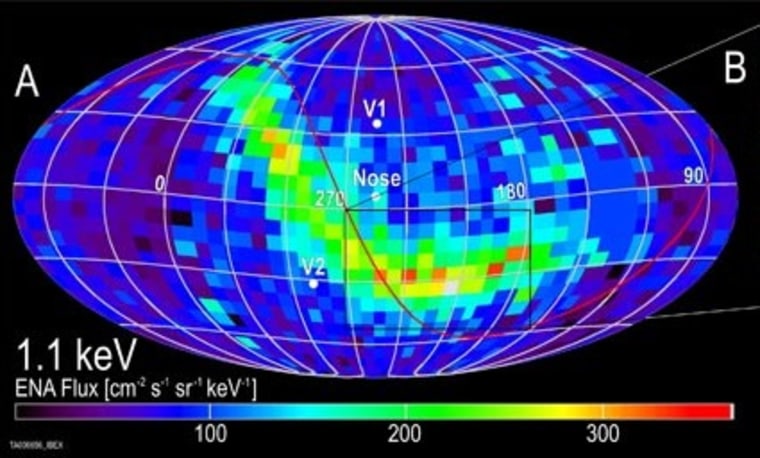A mysterious ribbon spotted on the edge of the solar system has turned out to be a reflection of particles streaming off the sun, scientists have found.
The space ribbon — a long band of high-energy particle emissions — was first noticed last year by NASA's IBEX (Interstellar Boundary Explorer) spacecraft, which studies the boundary between our solar system and the rest of the galaxy. Scientists were mystified by it, calling the discovery a "shocking result."
But now researchers think they've figured out the origin of the bizarre structure.
"We believe the ribbon is a reflection," said Jacob Heerikhuisen, a NASA heliophysics guest investigator from the University of Alabama in Huntsville. "It is where solar wind particles heading out into interstellar space are reflected back into the solar system by a galactic magnetic field."
The sun emits a stream of charged particles called the solar wind. These particles apparently travel out to the edge of the solar system, where they encounter a strong magnetic field coming from the rest of the galaxy, that slingshots them back in the direction they came from.
"This is an important finding," said Arik Posner, IBEX program scientist at NASA headquarters in Washington, D.C. "Interstellar space just beyond the edge of the solar system is mostly unexplored territory. Now we know, there could be a strong, well-organized magnetic field sitting right on our doorstep."
IBEX is an Earth-orbiting spacecraft that was launched in October 2008 to monitor incoming neutral atoms that originate billions of miles away at the boundary between the solar system and the cold expanse of space.
The ribbon IBEX saw is vast and stretches almost all the way across the sky, suggesting that the magnetic field behind it must be equally huge. The structure emits no light, but rather sends out these energetic neutral particles that IBEX then captures.
"If this mechanism is correct — and not everyone agrees — then the shape of the ribbon is telling us a lot about the orientation of the magnetic field in our corner of the Milky Way galaxy," Heerikhuisen said.
The solar system is passing through a region of the Milky Way filled with cosmic rays and interstellar clouds. The magnetic field of our own sun, inflated by the solar wind into a bubble called the heliosphere, substantially protects us from these things. However, the bubble itself is vulnerable to external fields. A strong magnetic field just outside the solar system could press against the heliosphere and interact with it in unknown ways.
"IBEX will monitor the ribbon closely in the months and years ahead," Posner said. "We could see the shape of the ribbon change — and that would show us how we are interacting with the galaxy beyond."
The researchers reported their findings in the Jan. 10th issue of the Astrophysical Journal Letters.
